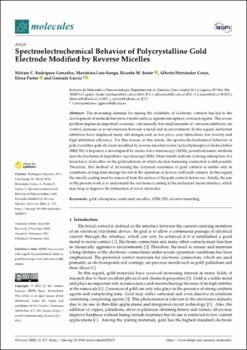Spectroelectrochemical behavior of polycrystalline gold electrode modified by reverse micelles.
Fecha
2021Resumen
The increasing demand for raising the reliability of electronic contacts has led to the
development of methods that protect metal surfaces against atmospheric corrosion agents. This severe
problem implies an important economic cost annually but small amounts of corrosion inhibitors can
control, decrease or avoid reactions between a metal and its environment. In this regard, surfactant
inhibitors have displayed many advantages such as low price, easy fabrication, low toxicity and
high inhibition efficiency. For this reason, in this article, the spectroelectrochemical behavior of
polycrystalline gold electrode modified by reverse micelles (water/polyethyleneglycol-dodecylether
(BRIJ 30)/n-heptane) is investigated by atomic force microscopy (AFM), potentiodynamic methods
and electrochemical impedance spectroscopy (EIS). Main results indicate a strong adsorption of a
monolayer of micelles on the gold substrate in which electron tunneling conduction is still possible.
Therefore, this method of increasing the corrosion resistance of gold contacts is usable only in
conditions of long-term storage but not in the operation of devices with such contacts. In this regard,
the micelle coating must be removed from the surface of the gold contacts before use. Finally, the aim
of the present work is to understand the reactions occurring at the surfactant/metal interface, which
may help to improve the fabrication of novel electrodes.






